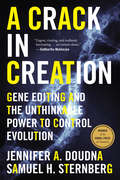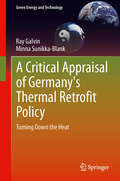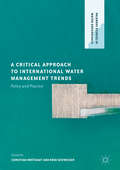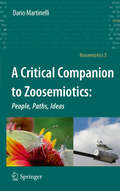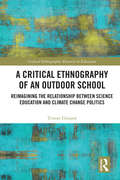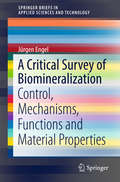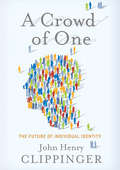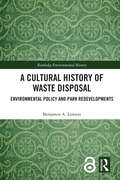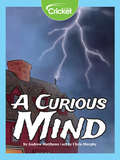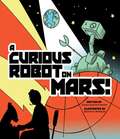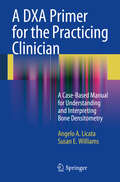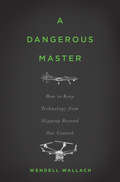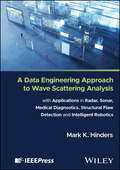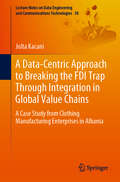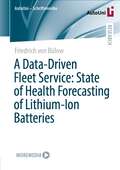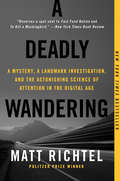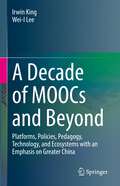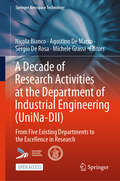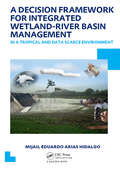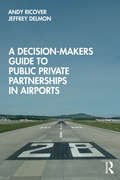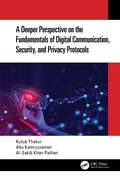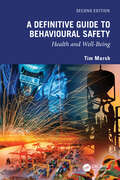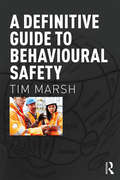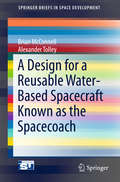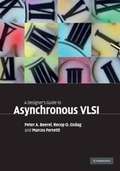- Table View
- List View
A Crack in Creation: Gene Editing and the Unthinkable Power to Control Evolution
by Jennifer A. Doudna Samuel H. SternbergA trailblazing biologist grapples with her role in the biggest scientific discovery of our era: a cheap, easy way of rewriting genetic code, with nearly limitless promise and peril. Not since the atomic bomb has a technology so alarmed its inventors that they warned the world about its use. Not, that is, until the spring of 2015, when biologist Jennifer Doudna called for a worldwide moratorium on the use of the new gene-editing tool CRISPR—a revolutionary new technology that she helped create—to make heritable changes in human embryos. The cheapest, simplest, most effective way of manipulating DNA ever known, CRISPR may well give us the cure to HIV, genetic diseases, and some cancers, and will help address the world’s hunger crisis. Yet even the tiniest changes to DNA could have myriad, unforeseeable consequences—to say nothing of the ethical and societal repercussions of intentionally mutating embryos to create “better” humans. Writing with fellow researcher Samuel Sternberg, Doudna shares the thrilling story of her discovery, and passionately argues that enormous responsibility comes with the ability to rewrite the code of life. With CRISPR, she shows, we have effectively taken control of evolution. What will we do with this unfathomable power?
A Critical Appraisal of Germany's Thermal Retrofit Policy: Turning Down the Heat (Green Energy and Technology)
by Ray Galvin Minna Sunikka-BlankGermany is seen as a leader in thermal retrofit policy and practice, but how effective is its approach? A Critical Appraisal of Germany's Thermal Retrofit Policy examines this policy in context and assesses its effectiveness. It finds that technical constraints and the costs of retrofitting reduce the rate of progress, while planning underestimates the influence of user behavior in the form of rebound and prebound effects. A key finding is that savings can be maximized within a policy that understands the actual behavior and motivation of households, the area where most energy savings are already taking place. The book suggests a new policy paradigm that would encourage a better balance of partial and comprehensive retrofits, utilizing household behavior changes based on a better understanding of fuel saving motivation and fuel price elasticity. In this approach, the thermal building regulations would be made more flexible so that policymakers would: - Promote partial, transitional and cost-optimal retrofits, which are more certain to pay back through fuel savings if they are appropriate to building typology and homeowner budgets. - Promote comprehensive retrofits for reasons other than economic gain, focusing instead on the comfort and environmental benefits of energy-efficient homes. - Invest more heavily in educating households to heat economically, learning from the prebound effect so as to maximize the utility of the homes they currently occupy, and base payback time calculations on actual consumption. The results and findings of this book would be of interest to policymakers, researchers and graduate students alike.
A Critical Approach to International Water Management Trends
by Christian Bréthaut Rémi SchweizerThis edited volume provides a critical discussion of particular trends that are widely recognised to influence water management by comparing them with what is actually happening in the field. Among others, these trends include water security, adaptive or integrative management, and the water-energy-food nexus, which are often presented as essential means to reaching more sustainable and resilient water use. However, the extent to which these trends have managed to structure concrete practices in water management remains uncertain. Informed by empirically grounded research, each chapter of this work engages with a particular approach, concept or theory. Together, they provide a nuanced picture of trends in water management that require universal remedies and global norms.
A Critical Companion to Zoosemiotics: People, Paths, Ideas (Biosemiotics #5)
by Dario MartinelliA critical companion of zoosemiotics is the first attempt to systematise the study of animal communication and signification through its most important and/or problematic terms and concepts, and its most representative scholars. It is a companion, in that it attempts to cover the entire range of key terms in the field, and it's critical, in that it aims not only to describe, but also to discuss, problematise and, in some cases, resolve, these terms.
A Critical Ethnography of an Outdoor School: Reimagining the Relationship between Science Education and Climate Change Politics (Critical Ethnographic Research in Education)
by Tristan GleasonBy using critical ethnographic research to explore the practices and policies that sustain a residential outdoor school in the US, this volume problematizes the relationship between science education and climate change politics in the United States. Weaving together empirical data from field work with theoretical resources spanning the sciences and humanities, this volume demonstrates how community activism, political alliances, and policy change have guaranteed the survival of an outdoor school in Oregon. This example enables artful re-examination of the relationship between science education, politics, and policy more broadly, as well as the relation of science education to climate change politics in particular. Gleason ultimately reconstructs science education towards epistemic and ontological pluralism, and illustrates how critical ethnographic research can instigate a reimagining of the relationship between curriculum and how we relate to the world. This text will benefit researchers, academics, and educators in higher education with an interest in the philosophical underpinnings and implications of science education, environmental education, and educational policy more broadly. Those specifically interested in critical ethnographic research will also benefit from this book.
A Critical Survey of Biomineralization
by Jürgen EngelThis monograph provides a comprehensive and up-to-date approach on biomineralization. The topical focus of the book lies on the question of how matrix proteins and cells catalyze and regulate mineralization in organisms. Recent advances in the understanding of biomineralization help to better understand biomaterials, in particular their mechanical properties. The target audience primarily comprises practitioners and research experts in the field, but the book may also be beneficial for graduate students.
A Crowd of One: The Future of Inidvidual Identity
by John HenryGreat leaps forward in scientific understanding have, throughout history, engendered similar leaps forward in how we understand ourselves. Now, the new hybrid disciplines of evolutionary biology and social physics are making the next leap possible-and fundamentally altering our notions of individual identity. If identity is a fact not derived from within the individual, but conferred on an individual by a group, or network, a host of assumptions about how governments work, how conflicts arise and are resolved, and how societies can be coaxed toward good are overturned. John Clippinger brilliantly illuminates how the Enlightenment itself-the high point of individual assertiveness-was a product not just of a few moments of individual inspiration and creativity, but rather of a societal shift that allowed innovation and creativity to flourish. Michelangelo owes quite as much to the circumstances of the Renaissance as the Renaissance does to the work of Michelangelo. Now, the digitalization of society, which affects all of us already, allows new insight into these questions: What does it require for societies, organizations and individuals, to thrive? Who decides who you are? How can happiness be shared and spread? Who can you trust?
A Cultural History of Waste Disposal: Environmental Policy and Park Redevelopments (Routledge Environmental History)
by Benjamin A. LawsonThis book offers a historical analysis of landfill sites in New York City, Greater Toronto, and Greater Tel Aviv, and uses them as case studies to emphasize the international and global scale of issues concerning waste disposal and park redevelopments.New York, Toronto, and Tel Aviv are currently redeveloping giant landfills into parks to much fanfare. The park redevelopments may be seen as an attempt to erase or assuage the decades of problematic waste-disposal policy that led to the creation of such large landfills. Booster rhetoric underscores this point, such as promoting how the parks will be a “green lung” for the city. This book contextualizes these redevelopments by offering a historical analysis, providing a greater understanding of the past, current, and future potential issues. It goes on to analyze the language and media coverage surrounding former waste sites becoming park redevelopments, including how cities use art to promote their image and gain cultural relevance. By engaging with both the works of waste historians and literature on waste and discard studies, the book provides theoretical models for analyzing the role of power in municipal systems, as well as human and ecological impacts on waste. It concludes with an analysis of the features necessary for landfill parks to be successful. This book will be useful for scholars, researchers, and academics studying waste studies, the environment, cities, and sustainable development, as well as for policymakers and environmental/eco artists.
A Curious Mind
by Andrew MatthewsBenjamin Franklin was often curious about the world around him. Utilizing observation and testing of the scientific method, he was able to invent many new items that improved the world for others. These inventions include his famous bifocal glasses, lightning rod, and even a long extension arm.
A Curious Robot on Mars!
by Bethany Straker James Duffett-SmithFar off into space--186 million miles to be precise--a fearless robot rover travels all by his lonesome. He is on a crucial mission from Earth, eagerly seeking to answer the much-anticipated question: Does life exist on Mars? But there is nothing to be seen on this planet except miles of rocks. He loses support from mission control and finds himself alone and cut off from civilization. But the curious little robot is resilient! After noticing a flash of light shining brilliantly through the crack of a rock, he instantly realizes his mission is far from over. He slowly inches towards the edge, but then suddenly falls perilously into the darkness! What will he discover?Bethany Straker's vibrant illustrations accompany James Duffett-Smith's suspenseful tale of discovery and hope. A Curious Robot on Mars! will motivate any and all readers to strive for one's ambitions--and most importantly, to always be curious!
A DXA Primer for the Practicing Clinician: A Case-Based Manual for Understanding and Interpreting Bone Densitometry
by Angelo A. Licata Susan E. WilliamsDespite public perception, osteoporosis remains a widespread, devastating disease, and a very serious and costly public health threat. Early detection and treatment must be a priority for primary health care providers. Dual-energy X-ray absorptiometry (DXA) is the principal x-ray technology used to diagnose osteoporosis in its early, asymptomatic stages, to assess treatment efficacy, and to guide treatment decisions. It remains the gold standard today. A DXA Primer for the Practicing Clinician: A Case-Based Manual for Understanding and Interpreting Bone Densitometry is developed around real cases of patients' DXA measurements. The content is derived from presentations given by the authors at a national society training course and exemplifies not only the complete body of education provided through these lectures but the full range of previously undiscussed nuances as well. This practical, easy-to-read title provides the day to day problems of DXA usage that new users may encounter and that training courses do not have time to provide in detail. The central focus of the book is the presentation of what is normal and what is problematic in the use of DXA, depicting various scenarios with real case histories of patients, their corresponding DXA images and the data that explain the problems. Unique in approach and presentation, this case-based manual will be of immense value to all practitioners -- and students - interested in providing optimal diagnosis and treatment of osteoporosis.
A Dangerous Master: How to Keep Technology from Slipping Beyond Our Control
by Wendell WallachWe live in an age of awesome technological potential. From nanotechnology to synthetic organisms, new technologies stand to revolutionize whole domains of human experience. But with awesome potential comes awesome risk: drones can deliver a bomb as readily as they can a new smartpho≠ makers and hackers can 3D-print guns as well as tools; and supercomputers can short-circuit Wall Street just as easily as they can manage your portfolio. One thing these technologies can’t do is answer the profound moral issues they raise. Who should be held accountable when they go wrong? What responsibility do we, as creators and users, have for the technologies we build? In A Dangerous Master, ethicist Wendell Wallach tackles such difficult questions with hard-earned authority, imploring both producers and consumers to face the moral ambiguities arising from our rapid technological growth. There is no doubt that scientific research and innovation are a source of promise and productivity, but, as Wallach, argues, technological development is at risk of becoming a juggernaut beyond human control. Examining the players, institutions, and values lobbying against meaningful regulation of everything from autonomous robots to designer drugs, A Dangerous Master proposes solutions for regaining control of our technological destiny. Wallach’s nuanced study offers both stark warnings and hope, navigating both the fears and hype surrounding technological innovations. An engaging, masterful analysis of the elements we must manage in our quest to survive as a species, A Dangerous Master forces us to confront the practical--and moral--purposes of our creations.
A Data Engineering Approach to Wave Scattering Analysis with Applications in Radar, Sonar, Medical Diagnostics, Structural Flaw Detection and Intelligent Robotics
by Mark K. HindersComprehensive resource exploring how recent advancements in computational capabilities open doors to new applications in wave scattering A Data Engineering Approach to Wave Scattering Analysis: with Applications in Radar, Sonar, Medical Diagnostics, Structural Flaw Detection and Intelligent Robotics applies scattering analysis to many applications including radar, sonar, medical diagnosis, intelligent robotics, and more, enabling readers to implement new and better measurements with both novel instrumentation and artificial intelligence that automates the interpretation of various (and multiple) imaging data streams. Composed of 10 chapters, this book brings together separate scientific topics that share a common basis of knowledge and their unchanged mathematical techniques to ensure successful results. Through periodic exercises, this book reinforces the importance of revisiting derivations and reproducing established results. It also delves into the individuals who shaped scientific methods and technologies, exploring 81 notable names and providing insights into their professional journeys. Classic results from scattering are included in each chapter, and rather than simply pasting in plots from classic papers, these results have largely been reproduced for a more coherent reader experience. Written by an established academic in the field, A Data Engineering Approach to Wave Scattering Analysis: with Applications in Radar, Sonar, Medical Diagnostics, Structural Flaw Detection and Intelligent Robotics includes information on various topics: Field equations, covering strain as a dimensionless measure of deformation, generalized Hooke’s Law, and elastic and acoustic wavesReflection and refraction, covering reflection from a free surface and surface waves as well as the wave model of acoustic microscopyGuided waves, covering torsional modes, longitudinal waves, and flexural waves in rods, as well as data engineering for lamb wave tomographyInverse scattering, covering wavelet transforms and fingerprinting as well as applications of wavelet fingerprints such as roof fall detection A Data Engineering Approach to Wave Scattering Analysis: with Applications in Radar, Sonar, Medical Diagnostics, Structural Flaw Detection and Intelligent Robotics is an essential up-to-date reference on the subject for researchers interested in radar, sonar, medical imaging, structural health monitoring, manufacturing process control, and autonomous vehicles, as well as upper-level undergraduates and graduate students in related programs of study.
A Data-Centric Approach to Breaking the FDI Trap Through Integration in Global Value Chains: A Case Study from Clothing Manufacturing Enterprises in Albania (Lecture Notes on Data Engineering and Communications Technologies #50)
by Jolta KacaniThis book reveals the hidden potential of emerging economies to become the new industrial hubs in existing global value chains. Pursuing a data-centric approach, it investigates the presence of foreign direct investment as an instrument for emerging economies to promote active participation in global value chains. This approach is based on time series analyses conducted at the national and industry level, and on datasets retrieved from international databases such as EORA, ICIO, and World Integrated Solutions. The outcomes of robust statistical models indicate that export-related innovations can improve trade openness and transform emerging economies into active players in global value chains. Researchers, developers, and professionals in the field will find a comprehensive and self-contained guide to the topic.
A Data-Driven Fleet Service: State of Health Forecasting of Lithium-Ion Batteries (AutoUni – Schriftenreihe #170)
by Friedrich von BülowGiven the limitations of state-of-the-art methods, this book presents a state of health (SOH) forecasting method that is suitable for lithium-ion battery (LIB) systems in real-world battery electric vehicle operation. Its histogram-based features can capture the higher operational variability compared to constant and controlled laboratory operation. Also, the transferability of a trained machine learning model to new LIB cell types and new operational domains is investigated. The presented SOH forecasting method can be provided as a cloud service via a web or smartphone app to fleet managers. Forecasting the SOH enables fleet managers of battery electric vehicle fleets to forecast and plan vehicle replacements.
A Deadly Wandering
by Matt RichtelA landmark exploration of the vast and expanding impact of technology, rivetingly told through the lens of a deadly collisionOne of the year's most original and masterfully reported books, A Deadly Wandering by Pulitzer Prize-winning New York Times journalist Matt Richtel interweaves the cutting-edge science of attention with the tensely plotted story of a mysterious car accident and its aftermath to answer some of the defining questions of our time: What is technology doing to us? Can our minds keep up with the pace of change? How can we find balance? Through Richtel's beautifully constructed narrative, a complex and far-reaching topic becomes intimate and urgent--an important call to reexamine our own lives.On the last day of summer, an ordinary Utah college student named Reggie Shaw fatally struck two rocket scientists while texting and driving along a majestic stretch of highway bordering the Rocky Mountains. Richtel follows Reggie from the moment of the tragedy, through the police investigation, the state's groundbreaking prosecution (at the time there was little precedent to guide the court), and ultimately, Reggie's wrenching admission of responsibility. Richtel parallels Reggie's journey with leading-edge scientific findings regarding human attention and the impact of technology on our brains--showing how these devices, now thoroughly embedded into all aspects of our lives, play to our deepest social instincts and prey on parts of the brain that crave stimulation, creating loops of compulsion, even addiction. Remarkably, today Reggie is a leading advocate who has helped spark a national effort targeting distracted driving, and the arc of his story provides a window through which Richtel pursues actionable solutions to help manage this crisis individually and as a society. A propulsive read filled with fascinating scientific detail, riveting narrative tension, and rare emotional depth, A Deadly Wandering is a book that can change--and save--lives.
A Decade of MOOCs and Beyond: Platforms, Policies, Pedagogy, Technology, and Ecosystems with an Emphasis on Greater China
by Irwin King Wei-I LeeThis book is an academic publication about the global development of massive open online courses (MOOCs) and major MOOC platforms worldwide in the past decade, as well as the outlook of MOOCs in the future, with an emphasis on Greater China. The book also discusses the upsurge of the demand for online learning and MOOCs during the COVID-19 pandemic.The book is divided into three main parts - Part I: Overview of MOOCs introduces the origin and history of MOOCs and the development of MOOC platforms in Greater China and the global context; Part II: Key Issues discuss the MOOC policies, innovative pedagogy, technology, and ecosystems worldwide; and Part III: Beyond MOOCs probes into the roles and benefits of MOOCs in times of crises, as well as the outlook of MOOCs in the future. In terms of topic diversity, the book contains a comprehensive investigation of the past and latest MOOC developments, extracting and elaborating on relevant information regarding platforms, policies, pedagogy, technology, and ecosystems. Subsequently, in-depth analyses of MOOC data are utilized to deduce the current trends related to the MOOC movement and to extrapolate the likeliest direction of development for MOOCs in the years to come. The book can inform policymakers, education institutions, course instructors, platform developers, investors, researchers, and individual learners of MOOCs about critical information on the present and future of MOOC development, assisting them in making crucial decisions on what initiatives can optimize their advantages in the sector.
A Decade of Research Activities at the Department of Industrial Engineering: From Five Existing Departments to the Excellence in Research (Springer Aerospace Technology)
by Sergio De Rosa Nicola Bianco Agostino De Marco Michele GrassiThis open access book celebrates the decennial of the Department of Industrial Engineering of Università di Napoli Federico II, Italy. It covers the main research achievements developed at the department in the fields of aerospace, marine, energy, statistical, mechanical and management engineering. Five pre-existing departments merged in 2013, and the research results are here summarized to certify how important it was to join skills, expertise, and projects. The industrial engineering area is huge, but it is now dominated by the need to conceive and analyze new solutions, human and climate oriented to face with the actual challenges which dictate the new paradigm, which evolved from “is it feasible?” to “is it compatible with the environment and the human beings?”. There is still a lot to do, but the contents of this book demonstrate that the first steps have been done. All the researchers of the department have contributed to this book, more than 140 authors, and thus, it isthe collective outcome of the path they were able to perform all together, including administrative officers and technicians. It highlights the international relevance and multidisciplinarity of research at the university as well as the planned research lines for the next years.
A Decision Framework for Integrated Wetland-River Basin Management in a Tropical and Data Scarce Environment: UNESCO-IHE PhD Thesis (IHE Delft PhD Thesis Series)
by Mijail Eduardo HidalgoTraditionally, wetlands were considered separately from river basin systems. However, nowadays it is becoming common practice to follow an integrated approach in wetland-riverine watershed analysis and management. Such approach requires not only adequate representations of all relevant bio-physical parameters, but also of socio-political and econom
A Decision-Makers Guide to Public Private Partnerships in Airports
by Jeffrey Delmon Andy RicoverAirport development is critical to economic growth and poverty reduction. This book will help decision-makers assess whether Public Private Partnerships (PPP) might be a viable option to meet their airport development requirements. It walks the reader through the airport PPP process, from early preparation to bringing the project to market and managing the project during implementation. The book will help eradicate misconceptions about the role of the private sector in airport infrastructure. A Decision-Makers Guide to Public Private Partnerships in Airports provides an essential guide for those in a position to make decisions linked to airport development, to their advisers, their staff and also to students wishing to understand airport PPP.
A Deeper Perspective on the Fundamentals of Digital Communication, Security, and Privacy Protocols
by Al-Sakib Khan Pathan Kutub Thakur Abu KamruzzamanThis book, divided into three parts, describes the detailed concepts of Digital Communication, Security, and Privacy protocols. In Part One, the first chapter provides a deeper perspective on communications, while Chapters 2 and 3 focus on analog and digital communication networks. Part Two then delves into various Digital Communication protocols. Beginning first in Chapter 4 with the major Telephony protocols, Chapter 5 then focuses on important Data Communication protocols, leading onto the discussion of Wireless and Cellular Communication protocols in Chapter 6 and Fiber Optic Data Transmission protocols in Chapter 7. Part Three covers Digital Security and Privacy protocols including Network Security protocols (Chapter 8), Wireless Security protocols (Chapter 9), and Server Level Security systems (Chapter 10), while the final chapter covers various aspects of privacy related to communication protocols and associated issues. This book will offer great benefits to graduate and undergraduate students, researchers, and practitioners. It could be used as a textbook as well as reference material for these topics. All the authors are well-qualified in this domain. The authors have an approved textbook that is used in some US, Saudi, and Bangladeshi universities since Fall 2020 semester – although used in online lectures/classes due to COVID-19 pandemic.
A Definitive Guide to Behavioural Safety: Health and Well-Being, Second Edition
by Tim Marsh‘Behavioural safety’ or behaviour-based safety (BBS) has been around as a concept for several decades and is commonly held to mean directly tackling the frontline behaviours that lead to incidents and injury. Unfortunately, virulent criticism of some approaches of BBS frequently generalises to all others, so that commentators don’t know if they are arguing or agreeing. This book aims to cut through the waffle to be the one-stop guide to all the core theories and principles that underpin behaviour-based safety. In this second edition, internationally acclaimed behavioural safety expert Tim Marsh leads the reader through the three main strands: The awareness approach, the ‘walk-and-talk’ approach, and the Six-Sigma safety or the Deming-inspired ‘full’ approach that covers the systemic approach to safety observation, measurement, intervention, and analysis, but also incorporates emotional intelligence training aimed at enhancing supervisor-worker trust and communication more generally. Updated to reflect systemic changes due to the COVID-19 pandemic and featuring a brand-new chapter on well-being that discusses the massive changes in thinking about the interaction of culture and personal safety that have occurred since the previous edition was published. This book allows the reader to set up an ambitious and wide-ranging behavioural safety programme from scratch or refresh their current approach. Written by one of the world’s leading BBS experts, including leading the first major research project on the applied use of BBS outside of the US, based on the author’s experiences with more than 400 organisations Delivered in an accessible and popular writing style that simplifies complex theory and arguments in a user-friendly way, plus features end-of-chapter checklists to underpin learning Possesses a post-COVID focus, bringing behavioural safety into the 2020s, and covers the growing concept of well-being in a brand-new chapter. The title features end-of-chapter checklists to confirm understanding of the concepts. A Definitive Guide to Behavioural Safety is the go-to book for any practicing occupational health and safety professional.
A Definitive Guide to Behavioural Safety: The Definitive Guide
by Tim MarshThis book makes the case that far too much work undertaken under the banner of ‘behavioural safety’ is overly person-focused. ‘If you can walk on hot coals, you can do anything – so be safe’ needs to be dismissed out of hand, but also more advanced techniques based on coaching and empowerment fail to reflect the fact that, as ‘Just Culture’ models show, the great majority of causes of unsafe behaviour are environmental. Our methodologies mustn’t focus on the person with an open mind that there may be an underlying root cause; they must start from the statistically proven assumption that there is an underlying cause. This shift in mindset has a profound impact on the type of methodologies we must lead with, how they are used, how they are perceived, and last but certainly not least, their efficacy. A Definitive Guide to Behavioural Safety is a one-stop guide to all of the core theories and principles that underpin behaviour-based safety. All front-line behaviours that lead to incidents and injury are covered by the term behavioural safety, and getting to grips with the behaviours that might lead people to engage in unsafe or risky behaviour is crucial to prevention. In this book, internationally acclaimed behavioural safety expert Tim Marsh leads the reader through the three main strands: The awareness approach. The walk-and-talk approach. The Six Sigma safety or the Deming-inspired ‘full’ approach. Going through the very latest innovations in the field, the book covers the systemic approach to safety observation, measurement, intervention and analysis, but also incorporates emotional intelligence training aimed at enhancing supervisor–worker trust and communication more generally. A Definite Guide to Behavioural Safety is a perfect guide for any professional, whether you’re aiming to set up an ambitious and wide-ranging behavioural safety programme from scratch or you’re looking to refresh or extend an existing approach.
A Design for a Reusable Water-Based Spacecraft Known as the Spacecoach (SpringerBriefs in Space Development)
by Brian Mcconnell Alexander TolleyBased on components already in existence, this manual details a reference design for an interplanetary spacecraft that is simple, durable, fully reusable and comprised mostly of water. Using such an accessible material leads to a spacecraft architecture that is radically simpler, safer and cheaper than conventional capsule based designs. If developed, the potential affordability of the design will substantially open all of the inner solar system to human exploration. A spacecraft that is comprised mostly of water will be much more like a living cell or a terrarium than a conventional rocket and capsule design. It will use water for many purposes before it is superheated in electric engines for propulsion, purposes which include radiation shielding, heat management, basic life support, crew consumption and comfort. The authors coined the term "spacecoaches" to describe them, as an allusion to the Prairie Schooners of the Old West, which were simple, rugged, and could live off the land.
A Designer's Guide to Asynchronous VLSI
by Peter A. Beerel Recep O. Ozdag Marcos FerrettiBypass the limitations of synchronous design and create low power, higher performance circuits with shorter design times using this practical guide to asynchronous design. The fundamentals of asynchronous design are covered, as is a large variety of design styles, while the emphasis throughout is on practical techniques and real-world applications.
